7 Day Anagama Firing with Peter
Callas
March 30 thru April 12, 2000
At Dan Finchs' Pottery in Bailey, North
Carolina
In America an Anagama is usually loaded with
glazed functional ware and fired over a period of three to four days.
Using Callas technique, unglazed green ware is best suited to benefit
from ash deposit and build-up accumulated during an extended 7 day
firing process. The cooling down period is extended as well to create
a rustic -not glass/glaze-like- surface.
A combination of hard and soft wood will be
used (approx.12 cords). Workshop participants will assist Peter
Callas and his crew in stoking around the clock. The desired
temperature is 2300-2400 degree F (Cone 9-12). The firing is preceded
by 2 days of loading the huge 600cu feet kiln. Peter Callas is a
Master in the technique of tumble stacking a way of placing pottery
in the kiln that maximizes/equalizes heat distribution, ash deposit
and the intriguing art of "painting with fire".
|
Thursday
morning: Kiln loading
starts
Tumble stacking starts at
the narrow end of the kiln close to the chimney. (Note: site
ports will be used to stoke with kindling style wood, to
built up ashes and raise the temperature in the back of the
kiln)
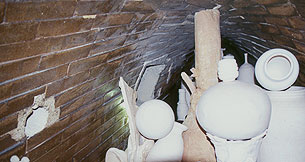
|
|
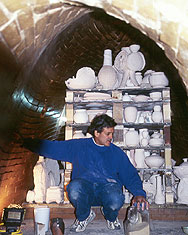
Sets of shelving were placed between
the 3 sets of site stoke ports to hold smaller pieces and
all of the glazed ware.
|
|
My orbs (approx. 65cm/25
1/2inch diam.) are placed under the front site
ports.

|
|
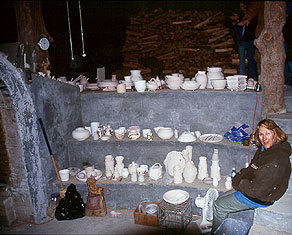
After 3-4 days of firing they will be
totally submerged in deep bed of amber/ashes.
Friday 2
am.: there is still a lot of
ware to be loaded.
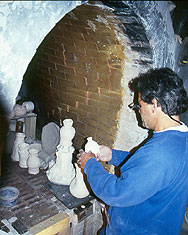
Saturday after
midnight: Peter is
contemplating the placement of a piece of pottery in the
fire box.
|
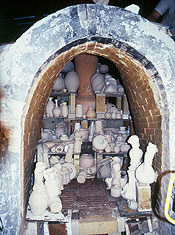
Saturday 4
am: Kiln loading is finished
The kiln door will be closed and a gas burner will be used
to raise the temperature inside the kiln to about 160
F.
|
|
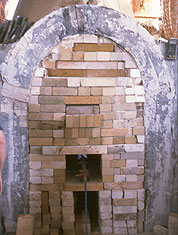
Goal:
Hold this temperature until kiln and ware are completely
dried out.
|
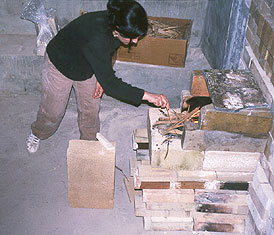
Saturday/Sunday:
The door is bricked in and the
building of the external combustion platform is completed.
Kindling with pine wood starts. To avoid thermal shock the
temperature will be raised slowly (approx. 30F/hr). This
outside combustion firing will continue for 2 days with the
temperature holding at approx. 800F.
Goal: to
build a bed of coal inside the kiln before fire box firing
starts and to have gas carry fly-ashes throughout the
kiln.
|
|
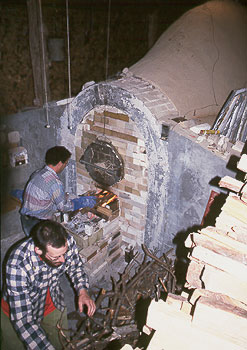
Monday
morning: Fire-box firing
starts
Goal: to
have the temperature rise 30 to 50 degrees per
hour.
Tuesday 9
pm. 1550F: side-stoking
starts
Temperature difference between back
and front inside the kiln is 250 F.
Goal:
Use side stoking to bring up the temperature in the back and
to have a bed of coal build up throughout the entire kiln
while stoking maintain a +/- 40 degree swing in
temperature.
|
|
Wednesday
midnight: Temperature is at
Cone 6 (2194 degrees F)
Thursday
afternoon: Temperature is at
Cone 11 (2361 degrees F) The temperature in the fire box is
200 degrees higher than in the back of the kiln.
Goal: to
hold the temperature in front while raising the temperature
in the back through more aggressive site stoking. At 9 pm
Cone 12 is bending and the temperature difference front/back
is reduced to 90 degrees.
Friday 1
am: firing down starts
Goal:
Rake amber in firing box gently to burn down coal and create
a protection blanket by covering the pieces in the firing
box first with small then with larger chunks of wood until
the entire box is filled - ending with a blanket of small
pieces. Stoke all site ports using kindling style oak to
fill kiln chambers up as high as possible. Seal the entire
kiln including chimney and damper. At 3:30 am the kiln is
sealed and the front/back temperature difference is 30
degrees.
Friday 4
am: Firing cycle is completed
The front/back temperature difference is 3
degrees.
|
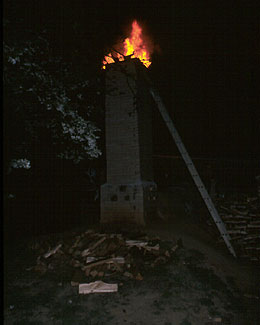
|
|
Kiln Opening: Tuesday
pm.
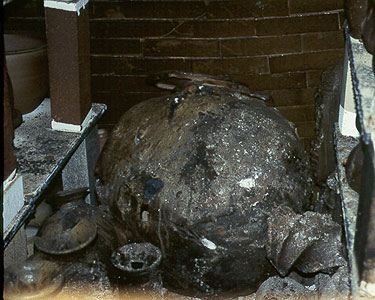
|
|
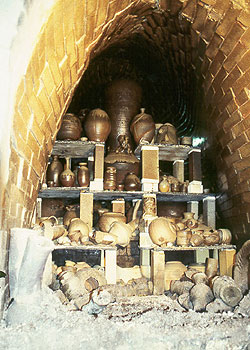
|
|
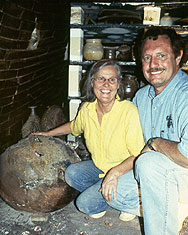
|
|
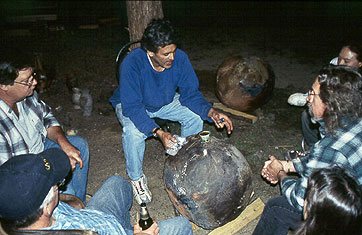
|
|
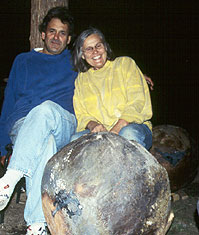
|
Back
to Index page














